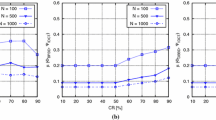Abstract
Remote health monitoring is one kind of E-health service, which transfer the users’ physiological data to the medical data center for analysis or diagnosis. Wireless body area network (WBAN) is a promising technology to achieve physiological information acquiring and delivering and thus has been widely adopted in remote health-monitoring applications. For WBAN, energy consumption is the major concern which has been addressed in many researches. Different from existing works, this work studies a joint scheduling and admission control problem with objective of optimizing the energy efficiency of both intra- and beyond-WBAN link. The problem is formulated as constrained Markov decision processes, and the relative value iteration and Lagrange multiplier approach are used to derive the optimal intelligent algorithm. Simulation results show the proposed algorithm is capable of, in comparison with greedy scheme, achieving nearly 100% throughput improvement in various power consumption budgets. Moreover, the proposed algorithm can achieve up to 5.5× power consumption saving for sensor node in comparison with other scheduling algorithms.






Similar content being viewed by others
References
Jermana M, Matheus R, Glauber V et al (2018) Advances in photopletysmography signal analysis for biomedical applications. Sensors 18(6):1894
Marques JAL, Cortez PC, Madeiro JPV et al (2018) Nonlinear characterization and complexity analysis of cardiotocographic examinations using entropy measures. J Supercomput. https://doi.org/10.1007/s11227-018-2570-8
Proakis JG (2001) Digital communications. McGraw-Hill, New York
Benharref A, Serhani MA (2014) Novel cloud and SOA-based framework for E-health monitoring using wireless biosensors. IEEE J Biomed Health Inf 18(1):46–55
Junnila S, Kailanto H, Merilahti J et al (2010) Wireless, multipurpose in-home health monitoring platform: two case trials. IEEE Trans Inf Technol Biomed 14(2):447–455
de Oliveira Júnior WG, Oliveira JMD, Munoz R et al. (2018) A proposal for internet of smart home things based on BCI system to aid patients with amyotrophic lateral sclerosis. Neural Comput Appl 2018:1–11
Cavallari R, Martelli F, Rosini R et al (2014) A survey on wireless body area networks: technologies and design challenges. IEEE Commun Surv Tutor 16(3):1635–1657
Patel M, Wang J (2010) Applications, challenges, and prospective in emerging body area networking technologies. IEEE Wirel Commun 17(1):80–88
He C, Fan X, Li Y (2013) Toward ubiquitous healthcare services with a novel efficient cloud platform. IEEE Trans Biomed Eng 60(1):230–234
Mahmoud MME, Rodrigues JJPC, Ahmed SH et al (2018) Enabling technologies on cloud of things for smart healthcare. IEEE Access 2018:1
Rodrigues JJPC, Segundo DBDR, Junqueira HA et al (2018) Enabling technologies for the internet of health things. IEEE Access 6:13129–13141
Abawajy JH, Hassan MM (2017) Federated internet of things and cloud computing pervasive patient health monitoring system. IEEE Commun Mag 55(1):48–53
Ghanavati S, Abawajy J, Izadi D (2016) An alternative sensor cloud architecture for vital signs monitoring. In: International joint conference on neural networks. IEEE
Hussein AF, Kumar A, Burbano-Fernandez M et al (2018) An automated remote cloud-based heart rate variability monitoring system. IEEE Access 6:77055–77064
Nia AM, Mozaffari-Kermani M, Sur-Kolay S et al (2015) Energy-efficient long-term continuous personal health monitoring. IEEE Trans Multi Scale Comput Syst 1(2):85–98
Zang W, Li Y (2018) Gait cycle driven transmission power control scheme for wireless body area network. IEEE J Biomed Health Inf 22(3):697–706
Su H, Zhang X (2009) Battery-dynamics driven TDMA MAC protocols for wireless body-area monitoring networks in healthcare applications. IEEE J Sel Areas Commun 27(4):424–434
Marinkovic SJ, Popovici EM, Spagnol C et al (2009) Energy-efficient low duty cycle MAC protocol for wireless body area networks. IEEE Trans Inf Technol Biomed 13(6):915
Liu B, Yan Z, Chen CW (2013) MAC protocol in wireless body area networks for E-health: challenges and a context-aware design. IEEE Wirel Commun 20(4):64–72
Argyriou A, Breva AC, Aoun M (2015) Optimizing data forwarding from body area networks in the presence of body shadowing with dual wireless technology nodes. IEEE Trans Mobile Comput 14(3):632–645
Li Y, Qi X, Keally M et al (2013) Communication energy modeling and optimization through joint packet size analysis of BSN and WiFi networks. IEEE Trans Parallel Distrib Syst 24(9):1741–1751
“Zigbee alliance,” http://www.zigbee.org/
Specification of the Bluetooth System version 4.0. Bluetooth SIG, June 2010. [Online]. http://www.bluetooth.com
Puterman M (1994) Markov decision processes. Wiley, New York
Altman E (1999) Constrained Markov decision processes. Chapman & Hall, London
Sennott LI (1999) Stochastic dynamic programming and the control of queuing systems. Wiley, New York
Sennott LI (1989) Average cost optimal stationary policies in infinite state markov decision processes with unbounded costs. Informs 37:626–633
Sutton RS, Barto AG (1998) Reinforcement learning: an introduction. MIT Press, Cambridge
Ngo MH, Krishnamurthy V (2010) Monotonicity of constrained optimal transmission policies in correlated fading channels with ARQ. IEEE Trans Signal Process 58(1):438–451
Acknowledgements
This work was supported in part by the National Natural Science Foundation of China (No. 61702497), Shenzhen Science and Technology Projects with Grant Number JCYJ20170412110753954.
Author information
Authors and Affiliations
Corresponding author
Ethics declarations
Conflict of interest
All authors declare that they have no conflict of interest.
Additional information
Publisher's Note
Springer Nature remains neutral with regard to jurisdictional claims in published maps and institutional affiliations.
Rights and permissions
About this article
Cite this article
Zang, W., Miao, F., Gravina, R. et al. CMDP-based intelligent transmission for wireless body area network in remote health monitoring. Neural Comput & Applic 32, 829–837 (2020). https://doi.org/10.1007/s00521-019-04034-x
Received:
Accepted:
Published:
Issue Date:
DOI: https://doi.org/10.1007/s00521-019-04034-x




